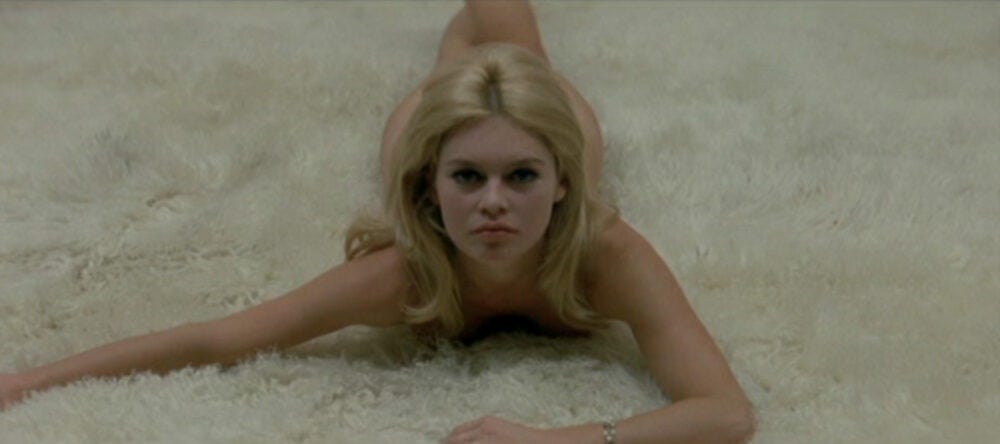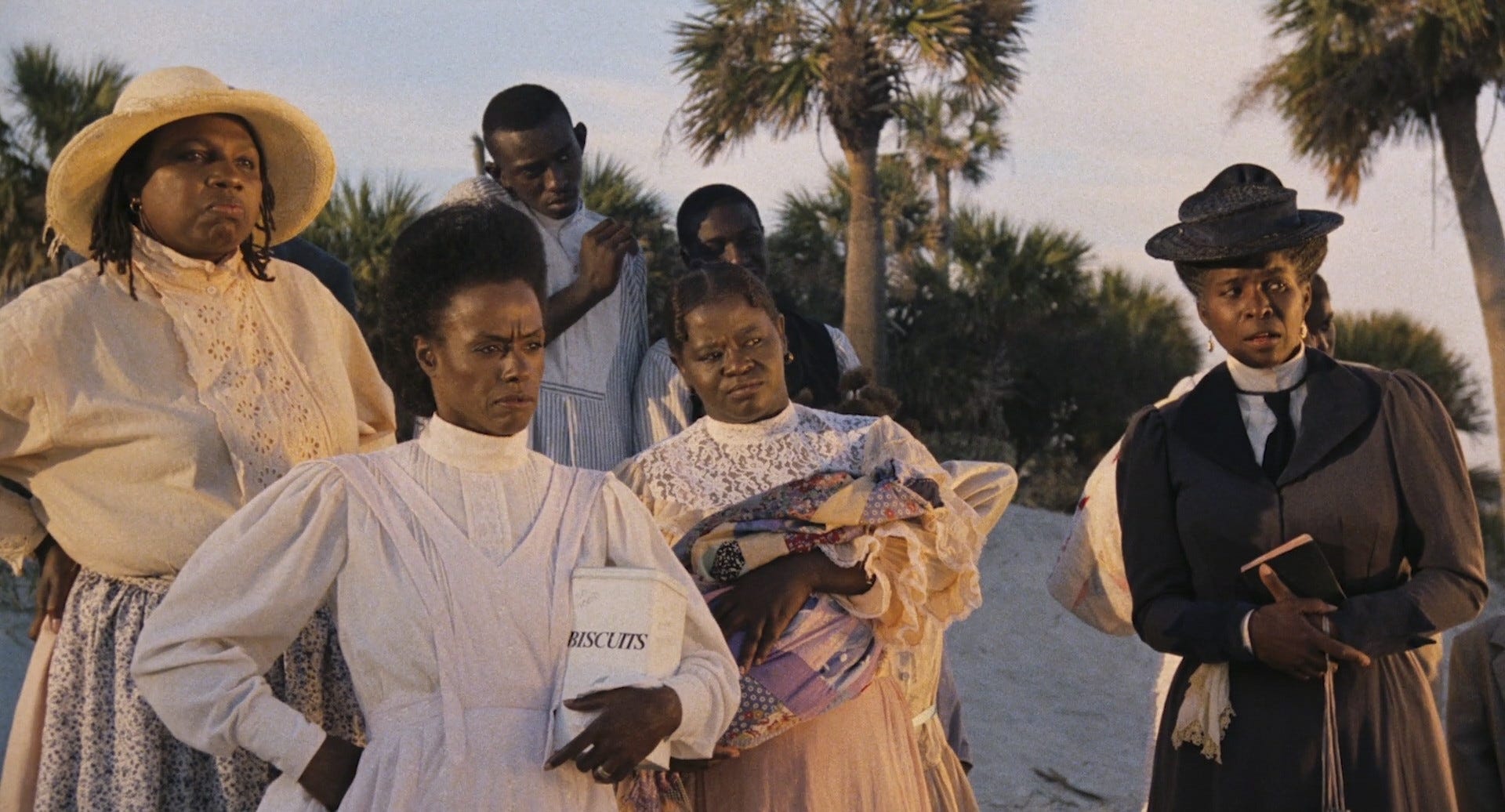Paging Dr. Lesbian - Does The Female Gaze Exist?
This is the Sunday Edition of Paging Dr. Lesbian. If you like this type of thing, subscribe, and share it with your friends. Upgrade your subscription for more. This week’s dispatch from the lesbian internet was about The New York Times’ foolishness and Ariana DeBose. If you get your updates on psychoanalytic theory from Tik Tok, you might be under the impression that ‘the female gaze’ is a widely accepted term of analysis. I’m not going to go too deep into how the term is used on the app, because it really boggles the mind, but I would like to discuss where the idea of the female gaze comes from and if it even makes sense as a descriptive concept. Does the female gaze actually exist? First of all, the female gaze isn’t actually a scholarly term, nor has it undergone rigorous evaluation. The concept emerged as a response to the idea of the ‘male gaze,’ a theory first defined by British film scholar Laura Mulvey in her 1975 essay “Visual Pleasure and Narrative Cinema.” In order to understand Mulvey’s ideas – and how they have trickled down into contemporary culture – we must first apprehend the theories that undergird her approach to the subject. Mulvey’s concept of the male gaze is rooted in two philosophies: apparatus theory and psychoanalysis. The main contention of apparatus theory is that film is primarily ideological and, in effect, reproduces the dominant ideology that it was created within. The goal of filmmaking, this theory argues, is to reproduce reality, and the so-called “magic” of cinema works to disguise its own construction, thus convincing audiences of its reality and therefore better indoctrinating them with ideology. This system has Marxist undertones, as the passive viewer corresponds with the uninformed proletariat who must awaken in order to start a revolution. Psychoanalysis is a theory rooted in Freudian analysis. Though it has often been critiqued for its implicit sexism and homophobia, feminist and queer theorists have nonetheless appropriated these ideas in order to explain and demystify the functions of the (hetero)patriarchy. Mulvey relies on the term phallocentrism, which, as it relates to the castration complex, essentially describes the privileging of the masculine in all things and the attendant anxiety around gender and sex. Mulvey plainly describes her use of psychoanalysis, noting that “psychoanalytic theory is thus appropriated here as a political weapon, demonstrating the way the unconscious of patriarchal society has structured film form.” Though the notion of the male gaze has long been misappropriated, Mulvey states her objectives with striking clarity. She writes that “unchallenged, mainstream film coded the erotic into the language of the dominant patriarchal order.” Well aware of how unpleasant it might seem to problematize our understanding of pleasure, Mulvey contends that “it is said that analyzing pleasure, or beauty, destroys it. That is the intention of this essay.” Mulvey argues that the goal is not to deny pleasure once and for all, but to create “a new language of desire,” one that is not simply in opposition to what has come before. So what is the male gaze? First, Mulvey defines two different ways of looking, both of which structure the composition of cinema’s gaze. The first manner of looking is scopophilic, which “arises from pleasure in using another person as an object of sexual stimulation through sight.” Put simply, scopophilia is defined as the pleasure of looking, which can be either aesthetic or erotic in nature. The second manner has to do with the ego libido, which is “developed through narcissism and the constitution of the ego, [and] comes from identification with the image seen.” The first structure of looking suggests a separation from what’s on screen, while the second suggests an identification and a closeness with what one sees. As such, the act of gazing in a cinematic context is presumed to be pleasurable, but is simultaneously threatening because the object of the gaze – ie. the woman – evokes this contradiction. Perhaps the most significant part of Mulvey’s essay is contained in the subheading “Woman as Image, Man as Bearer of the Look.” This distinction is defined fairly simply by Mulvey: “In a world ordered by sexual imbalance, pleasure in looking has been split between active/male and passive/female.” Though such a dichotomy is fundamental to filmmaking, it actually creates a problematic tension within the plot that must be solved. The woman is necessary within this visual spectacle, yet her presence there tends to halt the development of the narrative – she is a passive figure, after all. This problem needs to be repaired in order for the pleasures of gazing to remain intact and for the story to reach its satisfying climax. This structure demands that the viewer identify with the male figure who pushes the narrative forward. “The male protagonist is free to command the stage, a stage of spatial illusion in which he articulates the look and creates the action,” Mulvey writes. The male hero mirrors the ideal ego of the viewer, invoking a gaze of identification rather than eroticism. Importantly, it is the camera and the editing (as well as other behind-the-scenes elements) that allow him to be this controlling figure, which is why the gaze of the camera is an essential element within this configuration. If you’re keeping track, there are actually three gazes at play here: the look of the male protagonist, the look of the audience, and the look of the camera. The male gaze consists of these three looks. The theory does not simply refer to sexual objectification, though that is sometimes a part of it, but instead has more to do with the distinction between subject and object. There is a knowable, relatable figure (the man) and an unknowable idol (the woman). The woman becomes an object – an idol – in the eyes of the male protagonist, the viewer, and the camera. The filmmaking medium works to control both time and space in the visual field, and these “cinematic codes create a gaze, a world, and an object, thereby producing an illusion cut to the measure of desire.” The look of the camera has to be absent in order for the scopophilic, ego-induced gazes of the audience and the characters to be achieved. These cinematic conventions and techniques fix the spectator, and “the look of the audience is denied an intrinsic force.” Because of this rooted passivity, the viewer embodies the male gaze, regardless of their own innate desires or personal identifications. According to Mulvey, recognizing the tricks of cinema and the position of the audience is key to dismantling the cinematic status quo. “The first blow against the monolithic accumulation of traditional film conventions (already undertaken by radical filmmakers) is to free the look of the camera into its materiality in time and space and the look of the audience into dialectics, passionate attachment,” she writes. As Mulvey concedes at the beginning of the essay, this kind of analysis is in the business of destroying pleasure, but that doesn’t mean new pleasures aren’t possible. So, after all that analysis, can we imagine a world where the female gaze exists? The problem with the concept of the female gaze is this: Mulvey contends that the male gaze is inherent to cinema. Because films are produced in a patriarchal context, this ideological – and material – structure defines the outcome. Putting women behind the camera, making films that center on female protagonists, or, to put it even more crudely, having women objectify men, doesn’t magically deflate over a century of cinematic production. The structure of filmmaking has not fundamentally changed. Even work that portends to embody the female gaze emerges in opposition to the male gaze. The dichotomy between subject and object still exists, and the antithesis nevertheless recalls its mirror image. As Mulvey contends, a radical re-imagining of cinema is necessary before this monopoly can truly be undermined. Unfortunately, cinema and the male gaze have had over one hundred years to become entwined, which is why these ideas are so hard to disentangle. Speaking with Vulture about the concept of the female gaze, cinematographer Natasha Braier maintained that “[The male gaze] colonized the new medium from the start. You could say that it has become the official language of cinema. The female gaze, if there is such, never had the opportunity to truly develop and become something we can analyze.” Certainly, there are films that deny the power of the male gaze and propose their own language of cinema. I am thinking, for example, of Céline Sciamma’s Portrait of a Lady On Fire, which explicitly touches on the distinction between object and subject by way of painting. When I wrote about the film previously, I discussed it in terms of the ‘transformational gaze,’ an idea coined by film critic Mary Beth McAndrews. The transformational gaze works to transform both the film’s subjects (who in this case, are women) and the viewer by drawing attention to the oppressive structure of the male gaze. This attention, as you may recall, is something Mulvey contends is necessary to destroy the dominance of the male gaze. Portrait is also notable for how it eschews normative conventions of narrative conflict. Indeed, there isn’t much conflict to speak of. This distinction is important because conflict is another cinematic convention that tends to reproduce these gendered distinctions between active and passive, subject, and object. Though the film is quietly revolutionary, it would be reductive to say that because Sciamma is a lesbian or a woman, she possesses an inherent female gaze that is absolutely antithetical to the male gaze of cinema’s past. Indeed, this binary thinking isn’t radical at all, but the way Sciamma re-orders (or even throws out) the building blocks of cinema is. (I should note here that the film’s star, Adèle Haenel, actually left the film industry because she became convinced that the artistic revolution she wanted to be a part of was not possible within the industry itself. “I want to take part in another world,” she said.) While Sciamma has proudly called her movie a lesbian film and requests that it be referred to as such, it is a film that, in its structure, pushes against the binary opposition that defines the male and female gazes. We now find ourselves in a bit of a bind. The male gaze structures cinema and our instincts of looking as audience members, yet promoting such a thing as the female gaze doesn’t really seem to solve the problem. But we’re also giving a lot of weight to Mulvey’s theory here, a theory which has been heavily critiqued since it first appeared in 1975. There are a number of ways you can problematize the male gaze concept in terms of what it overlooks, but one of the most glaring omissions is that of race. Here is where we can bring in the work of bell hooks, who writes about the absence of intersectionality in Mulvey’s writing in her essay “The Oppositional Gaze.” hooks suggests that feminist film theory tends to assume the perspective of white women without explicitly noting this fact. She maintains that the psychoanalytic framework that the male gaze is rooted in “privileges sexual difference and actively suppresses recognition of race,” in essence recreating black women’s invisibility in the cinematic canon itself. hooks quotes Mary Anne Doane, who writes that “in focusing upon the task of delineating in great detail the attributes of woman as an effect of the apparatus, feminist film theory participates in the abstraction of women.” As such, black women are effectively erased by feminist film theory’s broad universalizations. Growing up a black girl in America, hooks quickly learned “there is power in looking.” Her understanding that the gaze can be dangerous led her to critically interrogate what it means to look, and especially what it means to look from a penetrating distance. Black women look “within a cinematic context that constructs our presence as absence,” hooks writes. Their unique experience of looking has been under-theorized, subsumed beneath the gaze of “all” (read: white) women or the gaze of black men. hooks argues that black women have defined for themselves a unique position of spectatorship. “Identifying with neither the phallocentric gaze nor the construction of white womanhood as lack, critical black female spectators construct a theory of looking relations where cinematic visual delight is the pleasure of interrogation.” Importantly, hooks is not suggesting an essentialist framework here – black women are not born with an oppositional gaze, but rather learn and create it themselves. Black women are not inherently resistant to the dominant forms of looking, and their mere presence does not amount to defiance. Instead, an active resistance must be chosen. But hooks goes further than suggesting mere refusal of dominant structures. “We do more than resist,” she explains. Citing the work of black women filmmakers like Julie Dash, hooks writes, “without providing “realistic” positive representations that emerge only as a response to the totalizing nature of existing narrative, they offer points of radical departure.” Rather than simply representing reality as it is or standing in opposition to negative representations, such revolutionary films have the ability to “constitute us as new subjects,” in the words of Stuart Hall. hooks maintains that the oppositional gaze can do more than just resist, it can also interrogate and invent. As hooks sees it, the passive viewer assumed by apparatus theory is not an inevitability. There are more radical positions that can be taken. The goal proposed (albeit differently) by both Mulvey and hooks is to create an alternative, rather than a reversal. When you consider cinema structurally, as Mulvey does, it is difficult to argue that such a thing as the female gaze exists, even with the inroads women have made in the industry since Mulvey’s time. Certainly, we could argue that those with less access to patriarchal power might gaze differently, but as hooks contends, this gaze is not natural or inherent, but rather learned and taught. A radical restructuring of looking, then, is still possible. “The decline of the traditional film form,” as Mulvey puts it, has not yet come to pass, but neither has the total decline of critical thought – one hopes.
You’re a free subscriber to Paging Dr. Lesbian. For the full experience, which includes weekly dispatches from the lesbian internet, become a paying subscriber. Your support means a lot! |
Older messages
a brief interruption
Sunday, February 19, 2023
*cough cough*
The Lesbian Tragedy of 'Gia'
Sunday, February 12, 2023
Tragedy is one of the oldest recognized classical art forms. More specifically, it's considered a classical art form, and is closely associated with the playwrights of Ancient Greece. Within
Queer Theory 101: Compulsory Heterosexuality
Sunday, February 5, 2023
Before There Was The 'Am IA Lesbian' Masterdoc, There Was Adrienne Rich
Girls On The Edge
Sunday, January 29, 2023
Re-assessing "Foxfire," a Queer '90s Classic
Towards a Global Queer Consciousness
Sunday, January 22, 2023
The Project of 'Queering The Map'
You Might Also Like
5 little treats for these strange and uncertain times
Sunday, March 9, 2025
Little treat culture? In this economy?
RI#266 - Down the rabbit hole/ What is "feels-like" temp/ Realtime voice tutor
Sunday, March 9, 2025
Hello again! My name is Alex and every week I share with you the 5 most useful links for self-improvement and productivity that I have found on the web. ---------------------------------------- You are
Chaos Theory: How Trump is Destroying the Economy
Sunday, March 9, 2025
Trump's erratic, chaotic governing style is dragging down the economy ͏ ͏ ͏ ͏ ͏ ͏ ͏ ͏ ͏ ͏ ͏ ͏ ͏ ͏ ͏ ͏ ͏ ͏ ͏ ͏ ͏ ͏ ͏ ͏ ͏ ͏ ͏ ͏ ͏ ͏ ͏ ͏ ͏ ͏ ͏ ͏ ͏ ͏ ͏ ͏ ͏ ͏ ͏ ͏ ͏ ͏ ͏ ͏ ͏ ͏ ͏ ͏ ͏ ͏ ͏ ͏ ͏ ͏ ͏ ͏ ͏ ͏ ͏ ͏
Chicken Shed Chronicles.
Sunday, March 9, 2025
Inspiration For You. ͏ ͏ ͏ ͏ ͏ ͏ ͏ ͏ ͏ ͏ ͏ ͏ ͏ ͏ ͏ ͏ ͏ ͏ ͏ ͏ ͏ ͏ ͏ ͏ ͏ ͏ ͏ ͏ ͏ ͏ ͏ ͏ ͏ ͏ ͏ ͏ ͏ ͏ ͏ ͏ ͏ ͏ ͏ ͏ ͏ ͏ ͏ ͏ ͏ ͏ ͏ ͏ ͏ ͏ ͏ ͏ ͏ ͏ ͏ ͏ ͏ ͏ ͏ ͏ ͏ ͏ ͏ ͏ ͏ ͏ ͏ ͏ ͏ ͏ ͏ ͏ ͏ ͏ ͏ ͏ ͏ ͏ ͏ ͏ ͏ ͏ ͏ ͏ ͏ ͏
“Hymn of Nature” by Felicia Dorothea Hemans
Sunday, March 9, 2025
O! Blest art thou whose steps may rove ͏ ͏ ͏ ͏ ͏ ͏ ͏ ͏ ͏ ͏ ͏ ͏ ͏ ͏ ͏ ͏ ͏ ͏ ͏ ͏ ͏ ͏ ͏ ͏ ͏ ͏ ͏ ͏ ͏ ͏ ͏ ͏ ͏ ͏ ͏ ͏ ͏ ͏ ͏ ͏ ͏
Claim Your Special Men's Health Offer Today!
Sunday, March 9, 2025
Subscribe to Men's Health today! Men's Health logo Get stronger, smarter, better 1 year of print mag + digital mag access Men's Health Magazine is the essential read for active, successful,
The 2025 Color Trends You *Should* Be Wearing Right Now
Sunday, March 9, 2025
They pack a playful punch. The Zoe Report Daily The Zoe Report 3.8.2025 The 2025 Color Trends You *Should* Be Wearing Right Now (Trends) The 2025 Color Trends You *Should* Be Wearing Right Now They
6 Most Common Tax Myths, Debunked
Saturday, March 8, 2025
How to Finally Stick With a Fitness Habit. Avoid costly mistakes in the days and weeks leading up to April 15. Not displaying correctly? View this newsletter online. TODAY'S FEATURED STORY Six of
Weekend: My Partner Can’t Stand My Good Friend 😳
Saturday, March 8, 2025
— Check out what we Skimm'd for you today March 8, 2025 Subscribe Read in browser Header Image But first: this is your sign to throw away your old bras Update location or View forecast EDITOR'S
Your Body NEEDS to Cardio Row! Here Are Some Options.
Saturday, March 8, 2025
If you have trouble reading this message, view it in a browser. Men's Health The Check Out Welcome to The Check Out, our newsletter that gives you a deeper look at some of our editors' favorite







